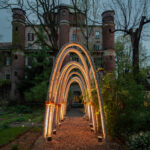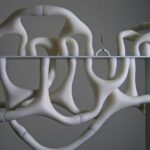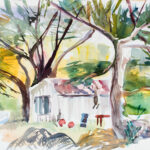Reflecting on this course has been incredibly cathartic and gratifying and I am sad to be leaving this experience behind. Coming from an non-design discipline, I was fearful that my foundational understandings from geography may have limited me from exploring environmental design challenges fully. Quite the opposite, I felt empowered to approach each course theme with an openness and empathy to understand the design complexities and perspectives on environmental issues.
Theme 1 in particular resonated deeply, as it introduced traditional design concepts I was unfamiliar with, while also focusing on the Western view of nature and culture I recognised. Exploring how Western hierarchy directly impacts the processes and systems of design provided a more nuanced perspective of this dualism unlike my previous, more generalised understanding of it. Investigating ‘third landscapes’ and navigating myself through Granton, uncovering intermediary zones between humans and nature, offered me an exciting opportunity to understand how designers can design for society and design for nature simultaneously. As a geographer, our role is to translate and identify ‘natural’ and ‘cultural’ intricacies by extracting the social, cultural, political, and/or economic meanings behind them, to better understand how we interact with and utilise the spaces and places around us. Viewing spaces through a designer’s eyes enabled me to grasp how one could translate these meanings into tangible outcomes. For me, this was a new way to interpret the Western hierarchy, and I immensely enjoyed viewing space from this perspective.
I now perceive the field of design as extending beyond just designing itself. While I initially believed design would encompass a multitude of things, from prototype sketches to aesthetics and functionalities to final products and constructions, I had failed to grasp, the wider, perhaps more aerial perspective, of how design provokes and engages with societal and environmental complexities in such a detailed way. Over the past nine weeks, I have concluded that for environmentally conscious design to be successful, designers must be adaptable; willing to change traditional or conventional processes; be capable of listening and responding empathetically to both nature and society; and have the ability to critically examine and learn from historic practices of design and modes of production. To witness future design thinkers adopting effective sustainable design, and moving away from the notion that humans are solely consumers, I have learnt we should embrace collective action and collaborative effort across various scales. This was especially gratifying to learn, because as a geographer we too work with a range of disciplines, sectors and actors and champion the interdisciplinary collaborative approach.
The final theme of the course, ‘Environmental Futures: Time, Hope and Possibilities in Design’, struck an unexpected chord in me. I already felt an overwhelming sense of anger, frustration, and a deep desire for action and change but am now also fundamentally invested in the call for change, both within and beyond design. This course transformed my somewhat defeatist mentality into a more hopeful attitude. Observing genuine attempts by many designers to prioritise environmental principles and stewardship gives me hope that a transition to a more sustainable way of designing is achievable on a large scale. My reflections are summarised by Van der Ryn and Cowan’s (2007) book ‘Ecological Design’:
“It is not a style. It is a form of engagement and partnership with nature that is not bound to a particular design profession”.
Van der Ryn and Cowan, 2007, p.34, Ecological Design.
Fundamentally these authors encapsulate what I believe this course has aimed to instill in me. That regardless of one’s own specialism, an interdisciplinary partnership with both society and nature is essential for proactive positive change and environmental decision making to happen.

References:
Van der Ryn, S. and Cowan, S., 2007. Ecological design.







